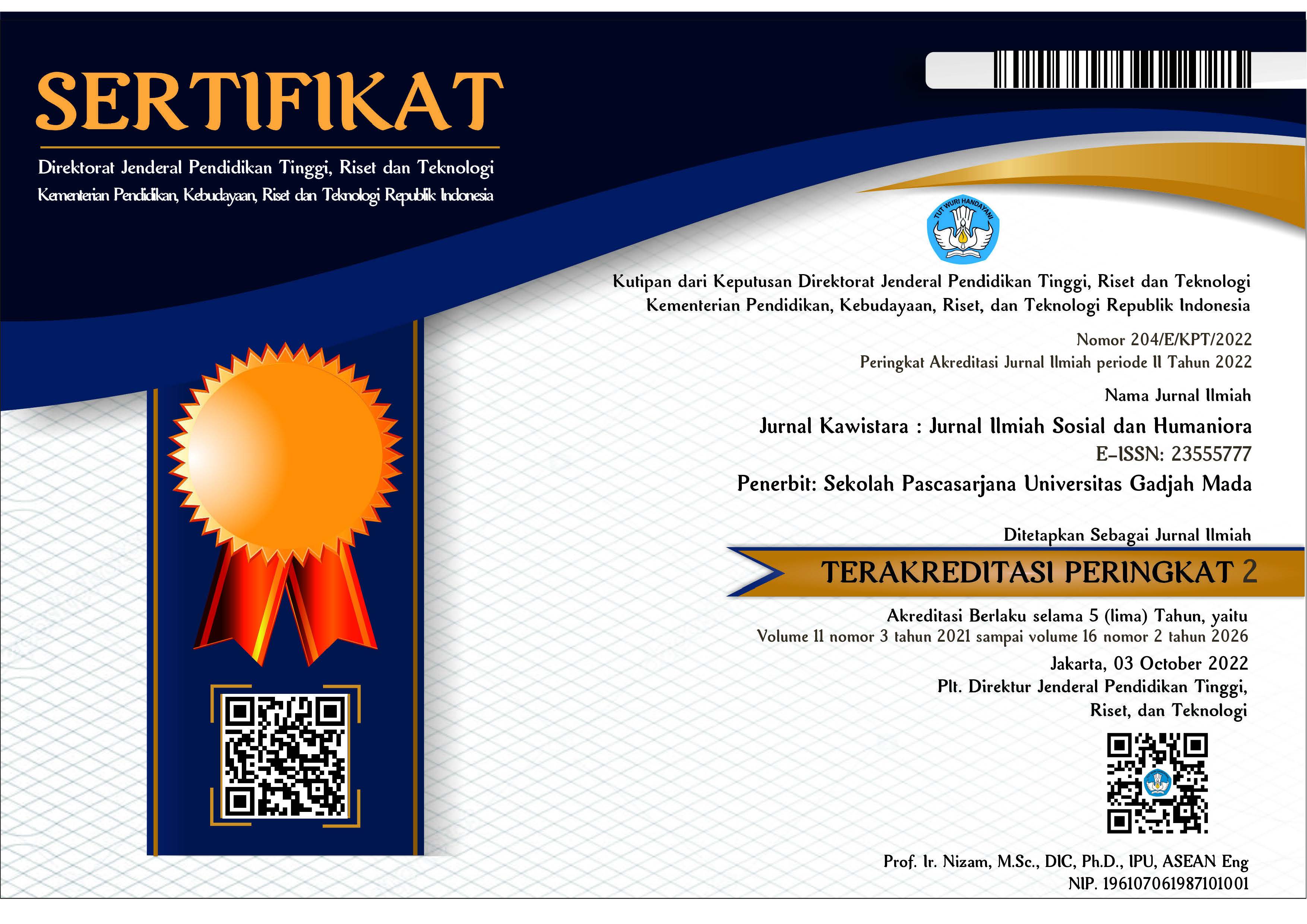Arena and (Re)Stabilization of Reog Bulkiyo Dance Cultural Production
Aprinus Salam(1*), Alfian Maulana(2)
(1) Universitas Gadjah Mada
(2) Universitas Gadjah Mada
(*) Corresponding Author
Abstract
Contestation among traditional art performances, in the technology and information era, creates complex and diverse challenge to the dance of Reog Bulkiyo. In 1999, the dance had to be stopped following the regeneration and economical problem. Although Reog Bulkiyo has been performed again since 2009, the conditions which makes this dance can be produced is still inexplicable. This article attempts to explain why dance experiencing production and activity stagnation. Pierre Bourdieu’s cultural production theory is used to analyze this problem, while ethnographic qualitative is used as the method. This study found that Reog Bulkiyo dance is in the arena of traditional dance art which has a double-tiered structure. The first structure leads to popular culture, while the second structure leads to art culture. In the first structure, Reog Bulkiyo dance group uses relational capital with relatives, social and Islamic groups to survive in the midst of competition with other popular arts. The dance then gains a relationship with the academy and the state which provides relational, cultural, and symbolic capital in the form of granting intangible cultural heritage status. These two relations give Reog Bulkiyo dance group the opportunity to maintain its cultural production.
Keywords
Full Text:
PDFReferences
Alfaqi, M. Z., & Azizah, R. S. (2022). Kajian Historis Reyog Bulkiyo dalam Prespektif Multiple Intelegences Strategi Penguatan Karakter Bangsa di Era Disrupsi. Sejarah Dan Budaya, 16(2), 344–353. https://doi.org/10.17977/um020v16i22022p344-353
Almeida, M. (2015). Structuralism. In International Encyclopedia of the Social & Behavioral Science (second). Orlando: Elsevier.
Bourdieu, P. (1972). Outline of a Theory of Practice. Mexico City: Cambridge University Press.
Bourdieu, P. (1993). The Field of Cultural Production (English Translation). New York: Columbia University Press.
Bourdieu, P. (1996). The Rules of Art: Genesis and Structure of the Field (S. Emanuel, Trans.). California: Standford University Press.
Dewi, N. (2012). Makna simbolik ragam gerak dalam pertunjukan “Reog Bulkiyo” di Desa Kemloko Nglegok Kabupaten Blitar (Undergraduate Thesis). Universitas Negeri Malang, Malang.
Golinski, J. (2005). Making Natural Knowledge: Constructivism and the History of Science. London: The University of Chicago Press.
Hesmondhalgh, D. (2006). Bourdieu, the Media and Cultural Production. Media, Culture & Society, 28(2), 211–231. https://doi.org/10.1177/0163443706061682
Kementerian Kebudayaan dan Pendidikan Indonesia. (2019). Reog Bulkiyo [Government]. Retrieved August 15, 2023, from Penetapan Warisan Budaya Takbenda Indonesia website: https://warisanbudaya.kemdikbud.go.id/?newdetail&detailTetap=1254#:~:text=Reog%20Bulkiyo%20merupakan%20kesenian%20tradisional,ritual%2C%20hiburan%20dan%20seni%20pertunjukan.
Kutikasari, P. (2018). Nilai-Nilai Kearifan Lokal yang Terkandung dalam Kesenian Reog Bulkiyo di Desa Kemloko Kecamatan Nglegok Kabupaten Blitar (Undergraduate Thesis). Universitas Negeri Malang, Malang.
Marjadi. (2023, August 24). Interview dengan Bapak Marjadi Ketua Kelompok Tari Reog Bulkiyo.
Mujiono, H. (2020). Perkembangan Tari Reog Bulkiyo di Desa Kemloko Kecamatan Nglegok Kabupaten Blitar: Kajian Teks dan Konteks (Undergraduate Thesis). Institut Seni Indonesia, Yogyakarta.
Ningsih, W. (2023, April 17). Reog Bulkiyo, Warisan Prajurit Pangeran Dipenegoro. Kompas.Com. Retrieved from https://www.kompas.com/stori/read/2023/04/17/110000779/reog-bulkiyo-warisan-prajurit-pangeran-diponegoro?page=all
Oebaidillah, S. (2019, October 4). Kemendikbud Tetapkan 267 Warisan Budaya Tak Benda. Media Indonesia. Retrieved from https://mediaindonesia.com/humaniora/263460/kemendikbud-tetapkan-267-warisan-budaya-tak-benda
Pemerintah Republik Indonesia. (2007). Peraturan Presiden Republik Indonesia Nomor 78 Tahun 2007 tentang Pengesahan Convention for The Safeguarding of The Intangible Cultural Heritage (Konvensi untuk Perlindungan Warisan Budaya Takbenda). Pemerintah Republik Indonesia. Retrieved from https://warisanbudaya.kemdikbud.go.id/dashboard/media/hukum/PERATURAN%20PRESlDEN%20REPUBLIK%20INDONESIA%20NOMOR%2078%20TAHUN%202007.pdf
Pemerintah Republik Indonesia. (2017). Undang-Undang Republik Indonesia Nomor 5 Tahun 2017 tentang Pemajuan Kebudayaan. Pemerintah Republik Indonesia. Retrieved from https://warisanbudaya.kemdikbud.go.id/dashboard/media/hukum/UU%20Pemajuan%20Kebudayaan%20RI%20Nomor%205%20Tahun%202017.pdf
Putri, F. A. (2015). Perkembangan bentuk penyajian Kesenian Jaranan Tril pada Paguyuban Turonggo Anom Budoyo Desa Rejowinangun Kecamatan Kademangan Kabupaten Blitar tahun 1971-2015 (Undergraduate Thesis). Universitas Negeri Malang, Malang.
Riady, E. (2019, November 2). Reyog Bulkiyo Blitar Ditetapkan Jadi Warisan Budaya, Ini Sejarahnya. Detiknews. Retrieved from https://news.detik.com/berita-jawa-timur/d-4769460/reyog-bulkiyo-blitar-ditetapkan-jadi-warisan-budaya-ini-sejarahnya
Rofiq, A. (2023, July 26). Ulang Tahun ke-168, Desa Kemloko Blitar Gelar Kirab Tumpeng Hasil Bumi. Jatimtimes.Com. Retrieved from https://jatimtimes.com/baca/293460/20230726/074600/ulang-tahun-ke-168-desa-kemloko-blitar-gelar-kirab-tumpeng-hasil-bumi
Rofiqoh, Z. K., & Rohmah, N. B. (2022). Dinamika dan Nilai Islam-Jawa dalam Kesenian Reog Bulkiyo di Desa Kemloko Tahun 1970-1999. Jurnal Humaniora, 9(2), 136–148.
Santoso, I. (2016). Pasukan Khusus Pangeran Dipenegoro masih Menari (Studi Historis Kesenian Tari Tradisional Reyog Bulkiyo Blitar). Jurnal Sosiologi Pendidikan Humanis, 1(1), 21–27. http://dx.doi.org/10.17977/um021v1i12016p021
Saraswati, A., & Narawati, T. (2017). Reog Bulkiyo Dance Learning to Incrase Student Patriotism Values. Panggung, 27(3), 225–235.
Sholeh, M. (2019, October 17). Reog Bulkiyo Blitar Masuk Terdaftar Sebagai Warisan Budaya Tak Benda. Times Indonesia. Retrieved from https://timesindonesia.co.id/wisata/233792/reog-bulkiyo-blitar-masuk-terdaftar-sebagai-warisan-budaya-tak-benda
UNESCO. (2003). Convention for the Safeguarding of the Intangible Cultural Heritage. UNESCO. Retrieved from https://ich.unesco.org/en/convention#art2
Wibowo, N. (2011). Musik Reog Bulkiyo dari Desa Kemloko Kecamatan Nglegok Kabupaten Blitar Jawa Timur (Undergraduate Thesis). Institut Seni Indonesia, Yogyakarta.
Article Metrics
Refbacks
- There are currently no refbacks.
Copyright (c) 2024 Aprinus Salam; Alfian Maulana

This work is licensed under a Creative Commons Attribution-ShareAlike 4.0 International License.
Jurnal Kawistara is published by the Graduate School, Universitas Gadjah Mada.











